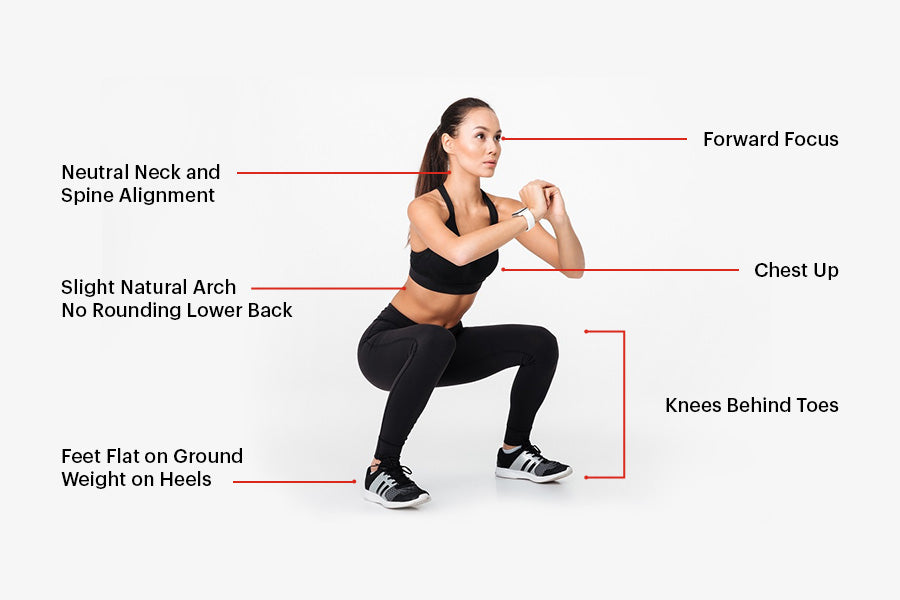Getting in shape and working out with squats can be a pain in the abs and legs, but it can hurt even more if you are doing it wrong, not to mention that it won't bear the expected results either.
Squats are awesome if you want to sculpt your body into shape, lose weight, flex your joints, and want killer abs, but to keep your hard work from going down the drain, you need to avoid some common mistakes related to squats.
Squats are perfect for everyone alike, whether you are an athlete or a common person trying to stay fit, adding squats to your routine means multiple benefits with one simple exercise.
Correct posture is the key to muscle building with squats; if you are doing even one thing wrong, you may as well stop doing it altogether because it will be fruitless. Those who wish to speed up the process can add weight to this excellent move. Weights bring in resistance, engage muscles more, and increase size and strength.
Grab your coffee and read till the end, so next time you squat, there is not a shred of doubt about its perfection.
What Happens When You Do Squats Incorrectly?
Before listing what you should avoid, we will tell you what happens when you squat incorrectly (so you take it more seriously).
First of all, your shins will hurt like hell. Quads, glutes, and hamstrings are the primary affected muscles during squats, and the weight of your body is on your heels. If you are doing it wrong, you will be feeling your weight on the toes. When your toes support your weight during a squat, you will not feel any pressure in your legs, meaning no muscle activation. In addition, you will have bad pain in your shins.
However, it doesn't mean you will not feel any pain post-workout when doing the squats right. Your legs will be sore after a wholesome squat session too. You should feel good when your glutes, hamstrings and quads are sore after squats. It means these muscles are working.
Second, the workout will lose its efficacy. If you are not following the proper technique, your workout may turn out to be just a waste of time and energy. It will not result in all the amazing effects that are supposed to come with squats.
Third, you will have lower back pain if you compromise the optimum posture for a squat. The focus point of squats is the leg muscles. They should be pulled and feel the pressure and pain of squats. If you feel pain in your lower back, you are doing it wrong. Lower back pain should alarm you that your posture and technique have been compromised.
Mistakes to Avoid While Squatting
Squats are essential for maintaining your lower body strength. They have many variations with or without weights. They do not just help bodybuilders increase muscle size, but they help increase functional strength too. This means squats are great for everyone because the pattern of movement comes in handy in daily life activities.
Avoid the mistakes discussed below if you do not want to go through the agony of useless squats. You will make the most of this move when you know what to avoid.
1. Forgetting to Warm-Up
Forgetting to warm up and going straight to the workout can catch your muscles off guard, further increasing the difficulty of sore muscles for you.
Warming up gets your body in the right frame for a workout and sets things in motion to prepare you for better performance. With a proper warm-up, you are good to go as low as you want while squatting, which is quite essential if you want to see solid progress in your squats movements.
2. Not Using Squat Pads

If you are doing weighted squats with a barbell, you must not forget to use the barbell squat pad. It makes the weighted squat comfortable and safe with its perfect padding and rugged surface.
Weight training comes with quite a few challenges of its own; there is no need to avoid comfort accessories like squat pads by DMoose, which absorb the extra shock that can hurt your shoulders and neck. You can also avoid skin abrasions which are unavoidable with a naked bar on your shoulders.
With the ergonomic design of the rubber pads, the barbell is safely placed at your back, too, as the pad’s surface helps hold the bar firmly. The weight is distributed evenly, which means added ease. Squats pads do not make you any less of a lifter: you just avoid the unnecessary discomfort and pain with it.
3. Not Breathing Properly
Breathing while doing your squats is also something you should add to your to-do list. You will tire soon or go out of breath: if you are not breathing correctly and you will lose stamina much faster.
If you are breathing correctly, you can effectively increase the count on your squats.
4. Sloppy Workouts
Being sloppy is never a good idea, but it's primarily a big mistake while you're in the gym doing your squats. You’ve got to stop using those techniques for the sake of your muscles because no one likes pain, am I right? Apart from pain, they waste your time in the gym because the moment you get sloppy, you miss the target.
All in all, try and work harder and not be lazy because it will cause sore muscles, all the same, but without any sculpting.
5. Incorrect Foot Placement
Now, it's also essential to choose the proper foot placement. Standing firm is the key to getting your squats right. It will activate and balance your quadriceps and hamstrings but, most importantly, the essential glute muscles so that you can squat perfectly.
6. Unstable Upper Back
Engagement of upper back muscles is critical. It helps you avoid any back injuries because your back is straight, stable and strong during the move.
It's crucial to stabilize your spine when doing a weighted squat. If your spine is wobbly and inclined to bend, results can be drastic. Life-changing injuries can result from a situation where the back muscles were not stabilized before pulling a weighted squat.
With an engaged back (upper and lower), you also automatically optimize body balance during the move.
7. Lifting Your Heels
Lifting your heels while squatting is a bad idea because it does nothing to make things easy, and your squats will miss their target too. Lifting your heels takes the necessary pressure away from your glutes and hamstrings, which is nothing but counterproductive.
It is also harmful to the shin and calf, giving you unnecessary pain.
8. Not Trying Squats Variations
There are many squats, such as sumo squats, squats with weights, and many more. They all come with amazing benefits. Variations help you perfect the move because your body gets used to performing it at various angles.
Alternating variations and not sticking to one type of squat will go a long way in maximizing its benefits.
9. Putting Too Much Pressure
Don't put unnecessary pressure on your feet and back. Avoid this, especially if you are a weight lifter, as it can hurt you after you finish the workout.
Do not lift too heavy while squatting, either. Unnecessary pressure on your shoulders and joints will not win you medals. Instead, the proper posture and reasonable weight will do the trick.
10. Rounding in Your Back
Keeping your back straight is essential here. Rounding it in will cause back pain. Keeping it straight helps distribute pressure evenly to all engaged muscles, but when you mistake bending unnecessarily, you put extra pressure on your backbone, which is a huge deal.
You aim to target and challenge the abs and legs: keep pressure away from your back.
11. Leaning Forward Excessively
Don't lean forward is another way of saying "keep your back straight.” Keeping the back straight is vital during squats because otherwise, it misses the target and becomes useless.
No one would want to go through the ordeal of having to squat every day without toning legs and abs.
12. Placing the Bar Too High or Low on Your Neck
Placing the bar too high or even too low on your neck can result in abrasions and injuries, so it's better to place it appropriately and keep low pressure on the bar as well. If your grip on the bar is not proper and strong enough, it can lead to a deadly bar slip.
So try your best grip and hold the bar as perfectly as you can while squatting.
13. Making a Half Move
Complete your squat movement and avoid a half move. This is essential because not finishing the whole squat and going only halfway can increase the risk of injury, especially in your legs.
Also, by doing only a half movement, you won't be able to reap all the benefits of a full squat, and all your sweat will go in vain.
14. Raising Your Hips Too Fast
While standing up in your squat movement, try not to raise your hips too fast. Keep the movement slow and controlled so that you don't injure your glute muscles and face unnecessary pain in your hips.
The controlled movement also helps challenge glutes and quads more. Keeping it slow works perfectly for beginners who are just learning to do it.
15. Turning your Knees Inward
Try to avoid turning your knees inward as you lower your body because that will put way more stress on your knees than they can handle. This mistake will lead to long-term joint damage.
The perfect way to avoid this is to point your knees outward while squatting. It helps prevent your knees from being sore and painful.
The Bottom Line
All in all, squats are something we all love while toning leg muscles. They strengthen your lower body big time if you do them right and avoid the mistakes mentioned above in the article.
Proper posture is the most important thing when it comes to squats. Keeping the body properly aligned is the key, no matter which variation you do. Small mistakes of posture can ruin your hard work. So, master your squats for toned legs and sculpted abs.
Reading List
Article Sources
- Bassil, Nazem, et al. ‘The Benefits and Risks of Testosterone Replacement Therapy: A Review’. Therapeutics and Clinical Risk Management, vol. 5, 2009, pp. 427–48. PubMed Central, https://www.ncbi.nlm.nih.gov/pmc/articles/PMC2701485/.
- The Benefits and Risks of Testosterone Replacement Therapy: A Review’. Therapeutics and Clinical Risk Management, vol. 5, 2009, pp. 427–48. PubMed Central, https://www.ncbi.nlm.nih.gov/pmc/articles/PMC2701485/.











